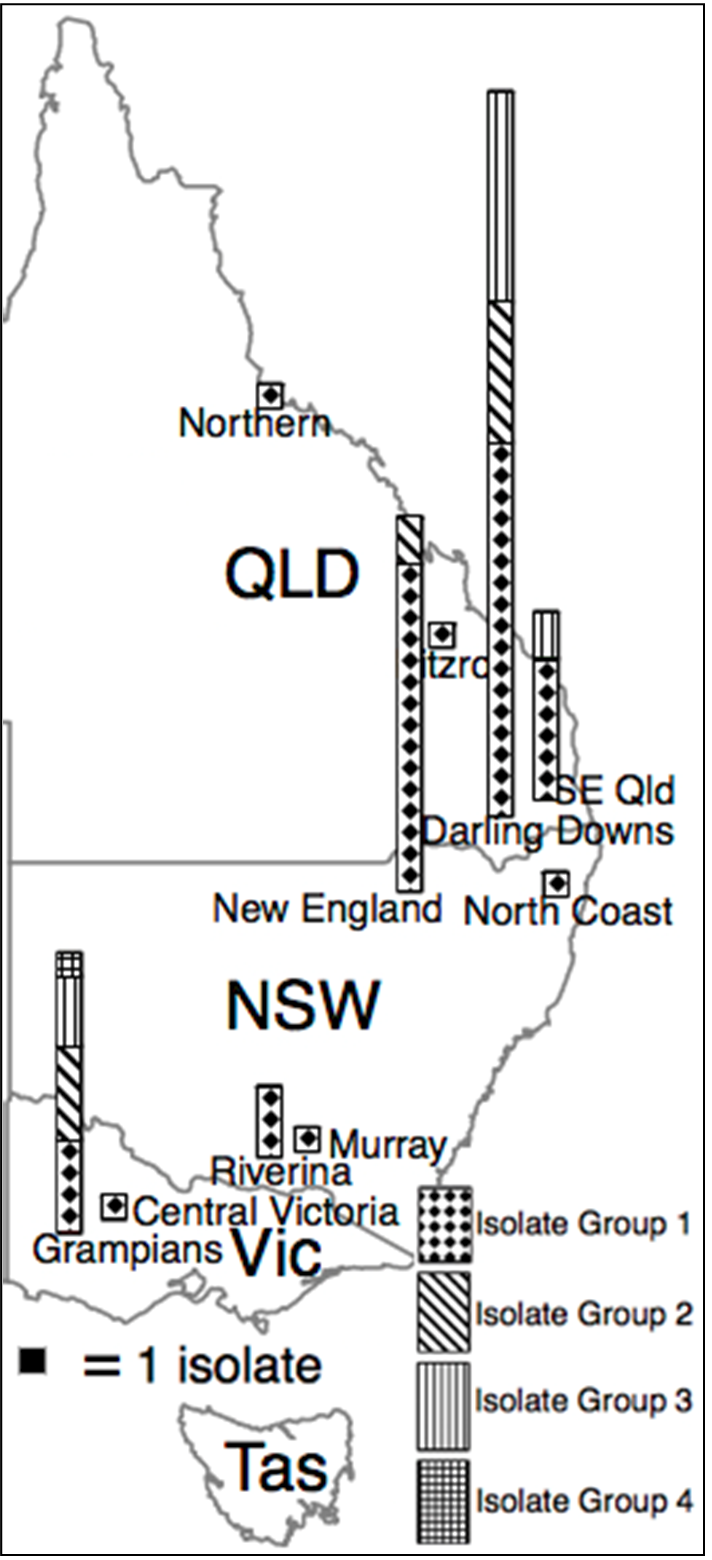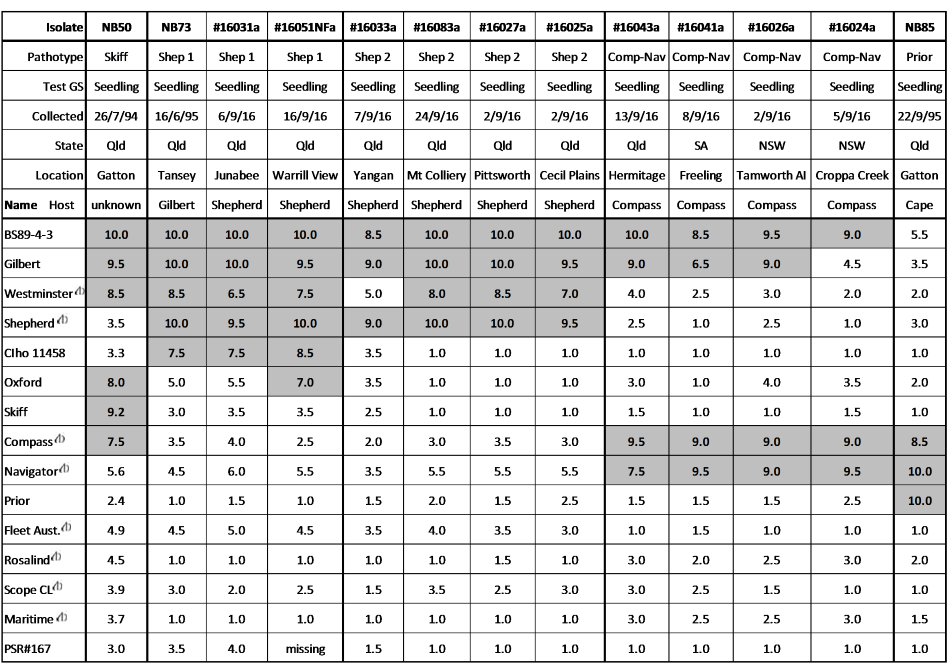Increased levels of net form of net blotch in Commander and Shepherd
Author: Ryan Fowler and Greg Platz, Dept of Agriculture and Fisheries | Date: 28 Feb 2017
Take home messages
- Prolonged and widespread sowing of Commander and Shepherd barley has allowed net form net blotch (NFNB) to adapt to these varieties.
- Pathotypes able to infect Commander and Shepherd, that were once rare, have increased in prevalence in recent years.
- NFNB can be spread via the sowing of infected seed that has not been treated.
- Sowing barley on barley or more specifically, sowing a variety back into stubble of that same variety, causes the disease to increase within paddocks over time.
- Environmental conditions play a major role in the development of NFNB, with wet conditions favouring infection and spread of the disease, like the spring of 2016.
- NFNB is best controlled by crop rotation, sowing of varieties with a disease rating of MS or better, treating seed prior to sowing, monitoring crops for NFNB during the season and timely application of a registered foliar fungicide before disease becomes conspicuous in an S to VS variety.
Background
Net form of net blotch is widespread throughout Australia and is found in most areas of the Northern Region. The disease persists in crop residues and infected seed between seasons. Frequent wet periods and mild temperatures favour disease development. Many different pathotypes of NFNB are present in the Northern Region and are able to infect most varieties, producing low to moderate disease symptoms on varieties rated as RMR to MSS. A very susceptible disease response occurs when a pathotype and a variety are fully compatible. NFNB has been an intermittent problem in the Northern Region, with some unusually wet years resulting in heavy epidemics on varieties such as Binalong and Skiff in New South Wales and Gilbert and Grimmett in Queensland.
Net Form Net Blotch in the Northern Region
GRDC fund national, annual pathotype surveys of NFNB and this work is conducted under the National Barley Foliar Pathogens Variety Improvement Program from The Hermitage Research Facility. These surveys have identified at least four distinct groups of isolates - across Australia (Fig.1 and Fig. 2). Collectively, these Isolates are able to successfully infect most varieties, though the level of disease development varies depending on the isolate/variety combination (Fig. 1).
Groups are assigned by the varieties on which they show a susceptible infection type.
Group 1 isolates are highly virulent on:
- Binalong, Cowabbie, Fairview, Grimmett, Skiff, Tantangara and Yambla
Group 2 isolates are highly virulent on:
- Gilbert and Grimmett
Group 3 isolates are highly virulent on:
- Commander, Grout, Keel, Mackay, Navigator and Prior
Group 4 isolates are highly virulent on:
- Beecher, Maritime and Roe
Shepherd and Granger and Fleet are susceptible to isolates that fall outside these groups; yet isolates that are virulent on Shepherd and Granger are avirulent on Fleet and vice versa.

M = Maritime, P = Prior, S = Skiff and T = Tallon. Fowler et al. 2017.
Pathotypes from Isolate Groups 1, 2 and 3 are present in the Northern Region (Fig. 1). The most prevalent pathotypes in the Northern Region are from Isolate Group 1 (Fig. 2).
Commander is quite susceptible at seedling growth stages to most pathotypes, yet does expresses a useful level of adult plant resistance to the predominant pathotypes (Isolate Group 1) found in the Northern Region. However, at adult growth stages Commander is quite susceptible to pathotypes that attack Prior, Corvette and Mackay (Isolate Group 3) see Table 1. These isolates are common in Queensland and appear to be increasing in NSW (Fig. 2).
Shepherd is susceptible to two pathotypes that fall outside these groups.
Commander and Shepherd have been the leading malt and feed varieties in the “old” Northern Region over the past five years. Large scale plantings have placed great selection pressure on the pathogen, resulting in increased virulence for their resistance profiles which has led to greater incidence and severity of NFNB in crops of these varieties. Selection pressures that have caused an increase in disease on Commander and Shepherd include:
- Adaptation of the pathogen for increased virulence
- Sowing any one variety over a prolonged period places selection pressure on the pathogen to adapt to that variety for its own survival and reproduction. Net blotches are sexually reproducing organisms and progeny of crosses that carry increased virulence for a variety are likely to increase over time. This means that virulence genes are gradually accumulated allowing the pathogen to better infect and colonise plants of that variety.
- Increased prevalence of existing or rare pathotypes
- Pathotypes that are highly virulent on Commander are common in Queensland and higher disease levels observed in NSW suggest that this pathotype is increasing farther south. See “Prior” pathotype in Table 1. The continued cultivation of Commander provides a selective host for Prior virulent pathotypes to increase.
- Two pathotypes that are highly virulent on Shepherd are present in Queensland.
- Shep 1 was detected in 1995 and has increased in prevalence in recent years (Table 1)
- Shep 2 was detected in 2015 and is now widespread over the Darling Downs. This pathotype has subtle differences from Shep 1 (Table 1)

Figure 2. Distribution of four NFNB isolate groups in eastern Australia. Fowler et al. 2017.
Table 1. Seedling response of 15 barley genotypes to 10 NFNB isolates collected from Compass and Shepherd in 2016 and three routine screening isolates (NB50, NB73, NB85) used at Hermitage Research Facility. Scores ≥6.5 indicate a susceptible response.

Net form net blotch control
Appropriate stubble management
Infested stubble is a source of inoculum for the following season. Avoid planting barley into barley stubble particularly if the crop that produced that stubble had conspicuous NFNB. It is best to follow a non-host crop like wheat, canola, chickpea etc. If you must plant barley on barley then removing the stubble by baling, incorporation by cultivation or even burning will reduce inoculum levels.
Resistant varieties
Sowing varieties with a resistance rating of MS or better is the most economical and convenient form of disease control. Resistance ratings are available on the NVT website or alternatively contact your agronomist or regional pathologist for further information.
Seed and in furrow treatment
During favourable conditions at flowering, the seed can become infected with NFNB. Seedlings from diseased seed can become infected with NFNB before they emerge. If planting seed was sourced from a crop that had significant NFNB then it should be treated with a systemic seed dressing containing active ingredients such as carboxin + thiram and difenoconazole to disinfect seed. Fluxapyroxad is reported to give systemic protection up to middle of heading (GS55). In furrow treatment of fertiliser with azxoxystrobin + metalaxyl-M is claimed to supress NFNB infection for up to 90 days.
Fungicides
Control with foliar fungicides should aim to protect the top two leaves and flag leaf sheath. Good results can be achieved with a single spray when a registered product is applied at around GS49 and before the target leaves become infected. Even better control can be achieved with a two spray strategy, one at GS31 and another at GS49. It is generally not economically worthwhile to apply fungicides to varieties with NFNB disease ratings of MS or better.
Crop monitoring
Fungicides are more effective if applied before NFNB becomes established. This demands regular crop monitoring from about mid tillering. In seasons that are particularly favourable for disease development more frequent monitoring may be necessary.
Conclusion
Net form net blotch is likely to continue to increase on Commander and Shepherd, necessitating an integrated approach to disease management for these varieties. Both varieties should still be able to be grown successfully with appropriate crop rotation, application of seed dressings, close monitoring of crops and timely fungicide application.
We are currently pathotyping samples collected in 2016 and a more comprehensive picture of the NFNB population in the Northern Region will be available by June.
Acknowledgements
The research undertaken as part of this project is made possible by the significant contributions of growers through both trial cooperation and the support of the GRDC, the authors would like to thank them for their continued support.
Contact details
Ryan Fowler
DAF Queensland
604 Yangan Rd, Warwick Qld 4370
Ph: 07 4660 3665
Mb: 0433 406 669
Email: ryan.fowler@daf.qld.gov.au
Greg Platz
DAF Queensland
604 Yangan Rd, Warwick Qld 4370
Ph: 07 4660 3633
Mb: 0408 733 055
Email: greg.platz@daf.qld.gov.au
GRDC Project Code: DAQ00187,
Was this page helpful?
YOUR FEEDBACK
